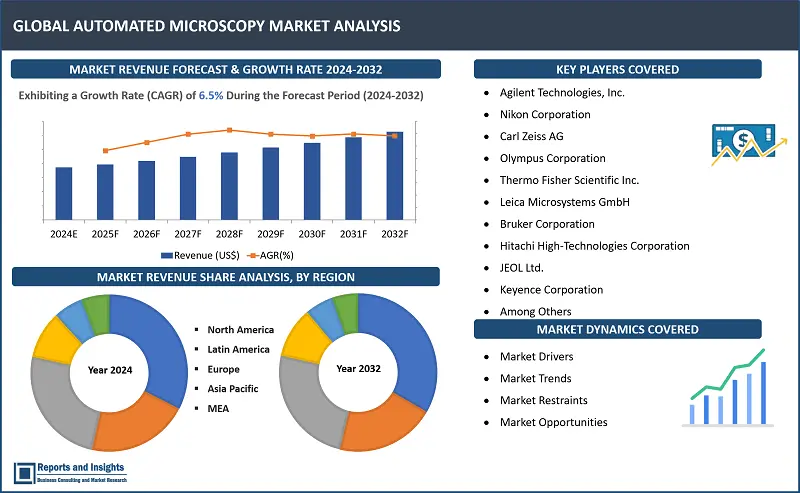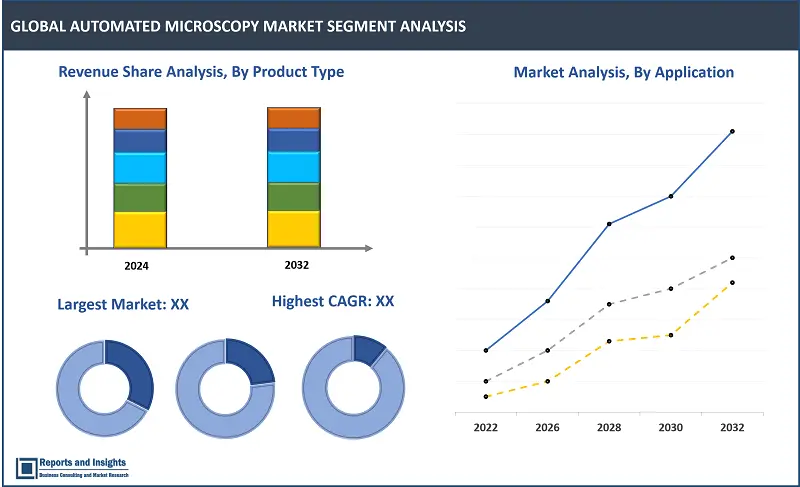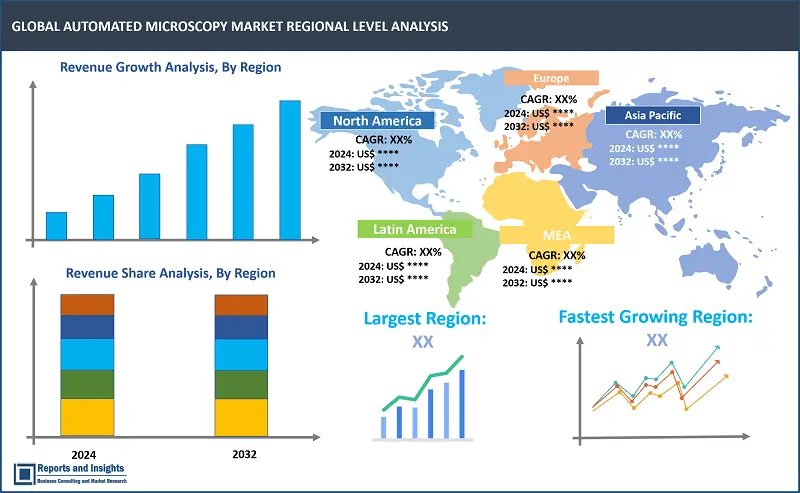Market Overview:
"The global automated microscopy market size reached US$ 108 billion in 2023. Looking forward, Reports and Insights expects the market to reach US$ 293.45 billion in 2032, exhibiting a growth rate (CAGR) 9.7% of during 2024-2032."
|
Report Attributes |
Details |
|
Base Year |
2023 |
|
Forecast Years |
2024-2032 |
|
Historical Years |
2021-2023 |
|
Market Growth Rate (2024-2032) |
9.7% |
Automated microscopy has emerged as a pivotal technology in various sectors, particularly in healthcare diagnostics and pharmaceutical and biotechnology industries. The automated microscopy market was valued at USD X,XXX.X million in 2023, and is expected to register a revenue CAGR of X.X% between 2024 and 2032. Some major factors supporting market revenue growth are technological advancements and government funding. Automated microscopy plays a significant role in healthcare diagnostics and has been gaining traction in early cancer diagnosis, offering increased accuracy and reproducibility, thus enhancing patient outcomes. Also, automated microscopy facilitates drug discovery and development processes, enables streamlining of workflows, and improves result accuracy in pharmaceutical and biotechnology sectors. In recent times however, integration of automation, Artificial Intelligence (AI), and Machine Learning (ML) in automated microscopy systems has been revolutionizing data analysis, and enabling access to more efficient and insightful data and information. Some of the leading names in microscopy include Nikon, Olympus, Agilent Technologies, Carl Zeiss, Hitachi High Technologies, Fei Company, and Bruker, and names such as Alentic Microscience, Horiba and CellPly are leading in the field of AI-assisted microscopy.
The benefits of automated microscopy extend beyond healthcare and pharmaceuticals and into more diverse fields such as materials science, forensics, and environmental monitoring. In addition, advancements in AI and ML integration in automated microscopy systems currently provides enhanced image analysis capabilities, automating tasks like image segmentation and classification.
Moreover, technological advancements and innovation have resulted in emergence of possibility for remote diagnostics, which necessitates telepathology solutions. Currently available solutions enable remote diagnosis of slides, thereby enhancing accessibility to healthcare services, especially in remote areas and settings. Cloud-based solutions also continue to gain popularity and traction, owing to cost reduction and simplicity of system usage. Another trend driving market growth is miniaturization of automated microscopy systems, which is resulting in development and introduction of portable and user-friendly systems.
Furthermore, some available service models allow pay-as-you-go access to automated microscopy systems, and this is becoming increasingly popular, as it does away with need for high upfront costs associated with these systems, and is an affordable and favorable option for a sizable consumer base.

Automated Microscopy Market Trends and Drivers
Growth of the global automated microscopy market is driven by key factors including emergence of new applications across medical, industrial, and commercial sectors, as well as in industries such as materials science, forensics, and environmental monitoring for precise analysis and quality control. This diversification of applications is driving market growth and encouraging competition between companies, as well as driving innovation in automated microscopy technologies.
Also, the rising demand for remote diagnostics, especially in healthcare, is resulting in steady incline in adoption of automated microscopy. Telepathology solutions integrated with automated microscopy systems enable remote diagnosis of samples, improving accessibility to medical services and enhancing patient care, particularly in underserved areas. In addition, rapid proliferation of cloud-based solutions is revolutionizing the way automated microscopy is utilized and managed, and cloud platforms are gaining increasing popularity due to scalability, cost-effectiveness, and simplified data management. Such platforms are also making automated microscopy accessible to a wider range of users worldwide.
Ongoing trends of integration with advanced technologies such as AI and ML are serving to enhance capabilities of automated microscopy systems and algorithms are automating image analysis, segmentation, and classification, leading to faster and more accurate results across applications. The miniaturization trend is also contributing significantly to growth of the automated microscopy system market. Development of more compact, smaller, lightweight, and portable systems are gaining traction and use for onsite analysis or in diverse settings, which offers flexibility and convenience. Additionally, availability of convenient service models that allow users to access automated microscopy systems on a pay-as-you-go basis, which reduces otherwise complex financial barriers to entry, and allows organizations to leverage benefits of these systems without need for substantial upfront investments.
Automated Microscopy Market Restraining Factors
Compliance with stringent safety standards adds complexity and cost to the development and deployment of these systems, deterring potential users. Moreover, cost factors present a major barrier to market growth. Automated microscopy systems are typically expensive to acquire and maintain, and these factors limit accessibility, especially for smaller research labs and institutions with budget constraints.
Research and Development (R&D) challenges also impact market growth and despite technological advancements, ongoing R&D efforts are required to address limitations such as image quality, resolution, and system reliability. Also, disadvantages associated with the use of automated microscopy, such as the need for specialized operating skills and concerns about data security, discourage wider adoption. Moreover, the availability of substitutes and alternatives, including manual microscopy techniques and alternative imaging technologies, provides users with other less cost-intensive and viable alternatives to automated microscopy.
Negative trends in the global automated microscopy market include slow adoption rates in certain industries and regions, as well as economic uncertainties affecting investment in advanced microscopy technologies. Furthermore, market saturation in mature economies and the lack of standardized protocols for automated microscopy further impact market expansion.
Automated Microscopy Market Opportunities
Manufacturers can focus on development of new products tailored to emerging applications in fields such as materials science, forensics, and environmental monitoring. By leveraging advancements in AI and ML, innovative systems can be designed with enhanced image analysis capabilities, improving accuracy and efficiency in various applications, and any product differentiation can attract new customer segments and expand market reach.
Engaging in strategic agreements, mergers, and acquisitions can facilitate market expansion and revenue growth. By partnering with or acquiring companies specializing in complementary technologies, automated microscopy manufacturers can broaden their technological capabilities and market presence. For instance, collaborations with firms in the cloud computing or telepathology sectors can integrate advanced remote diagnostics and cloud-based solutions into their offerings, making their systems more appealing and versatile. These strategic moves can also provide access to new geographical markets and customer bases.
In addition, leading companies can explore the service model to create additional revenue streams. Offering automated microscopy systems on a pay-as-you-go basis or through subscription models can lower the financial barriers for customers, thereby increasing adoption rates. This approach can attract smaller research labs and institutions with budget constraints, ensuring a steady revenue flow. Moreover, providing comprehensive training and support services can address the challenge of specialized operating skills, enhancing customer satisfaction and loyalty.
Automated Microscopy Market Segmentation

By Product Type
- Optical Microscope
- Electron Microscope
- Scanning Probe Microscope
Among the product type segments in the global automated microscopy market, the optical microscope segment is expected to account for the largest revenue share. This projection is supported by wide application in medical diagnosis, life science research, and drug discovery. Optical microscopes offer high-resolution imaging and are more cost-effective compared to electron and scanning probe microscopes, making these more accessible to a broader range of users. In addition, continuous technological advancements and integration with AI and ML serves to enhance functionality, and this trend is expected to continue to have a positive impact on revenue growth of this segment.
By Application
- Medical Diagnosis
- Life Science Research
- Drug Discovery and Pharmaceutical
The medical diagnosis segment is expected to account for the largest revenue share in the automated microscopy market. This significant share is driven by the increasing demand for accurate and efficient diagnostic tools in healthcare. Capability of automated microscopy to provide high-resolution imaging and early detection of diseases, particularly cancer, enhances its adoption in medical diagnostics. Furthermore, advancements in AI and ML improve diagnostic accuracy and speed, while the integration with telepathology solutions facilitates remote diagnostics, further boosting market growth.
By Region

North America
- United States
- Canada
Europe
- Germany
- United Kingdom
- France
- Italy
- Spain
- Russia
- Poland
- Benelux
- Nordic
- Rest of Europe
Asia Pacific
- China
- Japan
- India
- South Korea
- ASEAN
- Australia & New Zealand
- Rest of Asia Pacific
Latin America
- Brazil
- Mexico
- Argentina
Middle East & Africa
- Saudi Arabia
- South Africa
- United Arab Emirates
- Israel
- Rest of MEA
The global Automated Microscopy Market is divided into five key regions: North America, Europe, Asia Pacific, Latin America, and the Middle East and Africa. North America has been a leading regional market for payment processing solutions, with the United States playing a major role due to a robust financial ecosystem, advanced technological infrastructure, and a high degree of digital adoption, contributing to its leadership in the payment processing sector.
In Asia Pacific, countries such as China and India are registering significant growth in the global payment processing market. Rapid digitalization and dominance of mobile payments positions China ahead, with India following due to steady transitioning to digital transactions driving substantial incline in adoption of payment processing solutions.
In Europe, the United Kingdom, Germany, and France remain key contributors to growth of the payment processing market in the region. Common regional factors and trends driving overall growth of the global Automated Microscopy Market include increasing prevalence of e-commerce and mobile payments, continuous innovation in payment technologies, and rising focus on financial inclusion and digital transformation.
Leading Companies in Automated Microscopy Market & Competitive Landscape:
The competitive landscape in the global Automated Microscopy Market is intense, characterized by the presence of established players and the emergence of innovative fintech companies. Leading firms are adopting strategic measures to maintain their positions and expand their consumer bases. Continuous innovation in technology, with a focus on enhancing security features, improving transaction speed, and embracing emerging trends like blockchain and contactless payments are adding momentum to market growth. Also, strategic partnerships and collaborations with other industry players, fintech startups, and even traditional financial institutions is enabling companies to offer comprehensive solutions, expand market reach, and encourage innovation.
These companies include:
- Agilent Technologies, Inc.
- Nikon Corporation
- Carl Zeiss AG
- Olympus Corporation
- Thermo Fisher Scientific Inc.
- Leica Microsystems GmbH
- Bruker Corporation
- Hitachi High-Technologies Corporation
- JEOL Ltd.
- Keyence Corporation
Recent Development:
- May 23, 2024: After the successful launch of the BC43 CF benchtop confocal microscope in 2021, Andor announced expansion of its offerings to include benchtop fluorescence and super-resolution models. These new additions are crafted with considerations for cost-effectiveness, performance, and accessibility. The BC43 range aims to provide immediate clarity and depth to research endeavors, regardless of the sample, bridging the gap previously seen in larger and more complex systems. The objective behind this portfolio expansion is to democratize fluorescence, confocal, and super-resolution microscopy, making it accessible to a broader user base across various research fields and expertise levels. Among the new models is the BC43 WF, which is a compact and user-friendly widefield microscope tailored for automated imaging and smaller budgets. This entry-level system ensures hassle-free, high-quality fluorescence imaging, with the flexibility for in-field upgradability to confocal and super-resolution microscopy as needs and resources evolve.
- March 2024: Viavi Solutions Inc. announced the expansion of its fiber optic test solutions portfolio with the introduction of the INX 760 probe microscope. Representing the first fully automated probe microscope available in the market, the INX 760 offers the industry's swiftest inspection and analysis of single, duplex, and multi-fiber connectors. Its applications span across hyperscale data centers, metro core construction, telco distribution, and more. The INX 760 will be unveiled at the Optical Fiber Communication (OFC) Conference and Exposition from March 26-28, 2024, in San Diego, California. The INX 760 Probe Microscope streamlines every aspect of the inspection process, automating test setup, tip configuration, image focus, analysis, and data storage. Featuring interchangeable AutoID tips, the probe adjusts seamlessly to optimize inspection for various fiber connector types. Moreover, its internal panoptic imaging engine ensures an edge-to-edge field of view without compromising magnification or image resolution.
- September 2023: Nikon Corporation (Nikon) unveiled its latest innovation, the smart imaging system ECLIPSE Ji. This advanced system integrates Artificial Intelligence (AI) to automate the capture and analysis of cellular images, simplifying research processes related to cancer and nerve diseases. The ECLIPSE Ji is a digital inverted microscope designed to enhance research workflows. This system also eliminates the need for eyepieces, offering a modernized microscopy experience. By pairing the hardware with the NIS-Elements SE imaging software (to be released concurrently), users can conduct standardized assays. These assays encompass image acquisition, analysis, and data display, promising efficiency and accuracy in research endeavors.
Automated Microscopy Market Research Scope
|
Report Metric |
Report Details |
|
Market size available for the years |
2021-2023 |
|
Base Year |
2023 |
|
Forecast Period |
2024-2032 |
|
Compound Annual Growth Rate (CAGR) |
9.7% |
|
Segment covered |
Product Type, Application, Regions |
|
Regions Covered |
North America: The U.S. & Canada Latin America: Brazil, Mexico, Argentina, & Rest of Latin America Asia Pacific: China, India, Japan, Australia & New Zealand, ASEAN, & Rest of Asia Pacific Europe: Germany, The U.K., France, Spain, Italy, Russia, Poland, BENELUX, NORDIC, & Rest of Europe The Middle East & Africa: Saudi Arabia, United Arab Emirates, South Africa, Egypt, Israel, and Rest of MEA |
|
Fastest Growing Country in Europe |
UK |
|
Largest Market |
North America |
|
Key Players |
Agilent Technologies, Inc., Nikon Corporation, Carl Zeiss AG, Olympus Corporation, Thermo Fisher Scientific Inc., Leica Microsystems GmbH, Bruker Corporation, Hitachi High-Technologies Corporation, JEOL Ltd., Keyence Corporation |
Frequently Asked Question
What is the market size of the automated microscopy market in 2023?
The automated microscopy market size reached US$ 108 billion in 2023.
At what CAGR will the automated microscopy market expand?
The market is expected to register a 9.7% CAGR through 2024-2032.
Who are some of the market leaders in the automated microscopy market?
Companies such as Nikon Corporation, Carl Zeiss AG, and Olympus Corporation are recognized as leaders due to their extensive product portfolios, continuous innovation, and strong global presence.
What are some key factors driving revenue growth of the automated microscopy market?
Some key factors include technological advancements, increasing demand for accurate and efficient diagnostics, and rising government funding for life sciences research. Also, integration of artificial intelligence (AI) and machine learning (ML) is enhancing imaging capabilities and data analysis, thereby boosting adoption. Additionally, the growing application of automated microscopy in drug discovery, pharmaceutical research, and remote diagnostics further support market expansion.
What are some major challenges faced by companies in the automated microscopy market?
Companies in the automated microscopy market face several challenges, such as high costs associated with advanced microscopy systems, which can limit adoption, especially in smaller research institutions. Additionally, the need for specialized operating skills and data security concerns pose significant barriers. Market constraints also include intense competition and the availability of alternative imaging technologies that may serve as substitutes.
How is the competitive landscape in the automated microscopy market?
The competitive landscape of the automated microscopy market is characterized by intense competition among established players and new entrants. Major companies focus on innovation, product differentiation, and strategic collaborations to strengthen their market position. Partnerships, mergers, and acquisitions are common strategies employed to expand technological capabilities and market reach. The market also sees a significant emphasis on developing cost-effective and user-friendly systems to cater to a broader customer base.
How is the automated microscopy market segmented?
The market is segmented based on By Product Type (Optical Microscope, Electron Microscope, Scanning Probe Microscope), Application (Medical Diagnosis, Life Science Research, Drug Discovery and Pharmaceuticals).
Who are the key players in the global automated microscopy market?
Key companies included in the global automated microscopy market report are Agilent Technologies, Inc., Nikon Corporation, Carl Zeiss AG, Olympus Corporation, Thermo Fisher Scientific Inc., Leica Microsystems GmbH, Bruker Corporation, Hitachi High-Technologies Corporation, JEOL Ltd., Keyence Corporation

